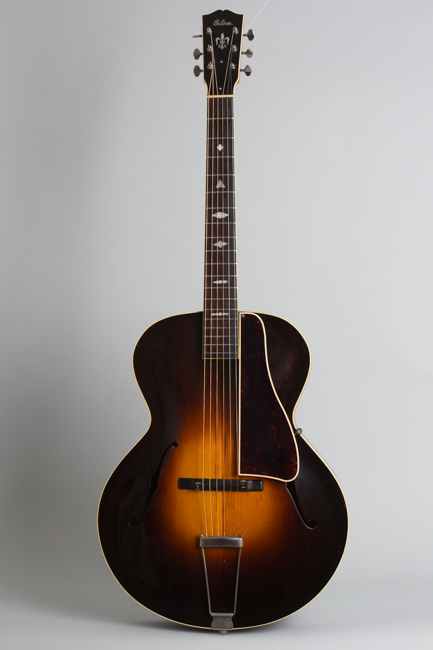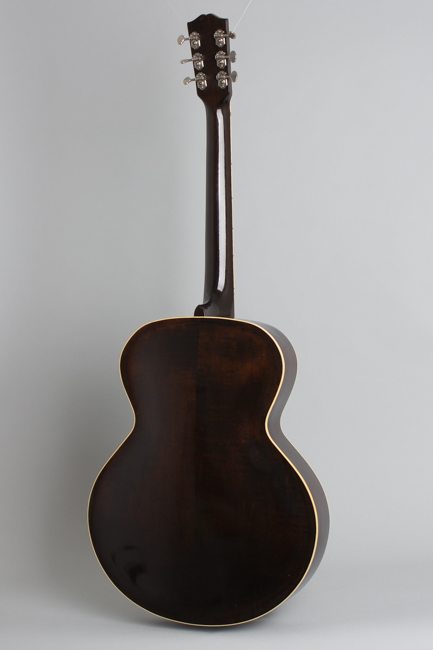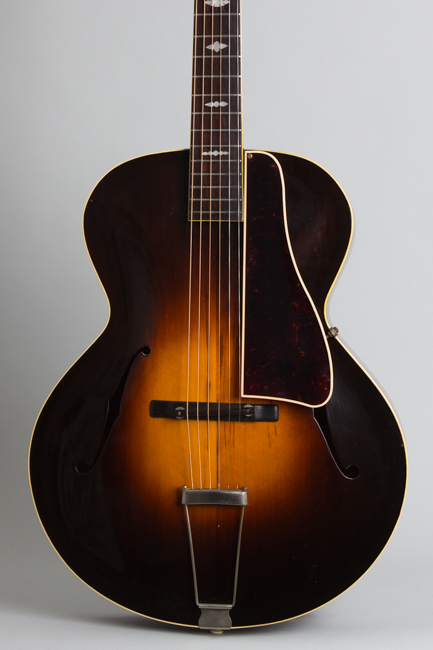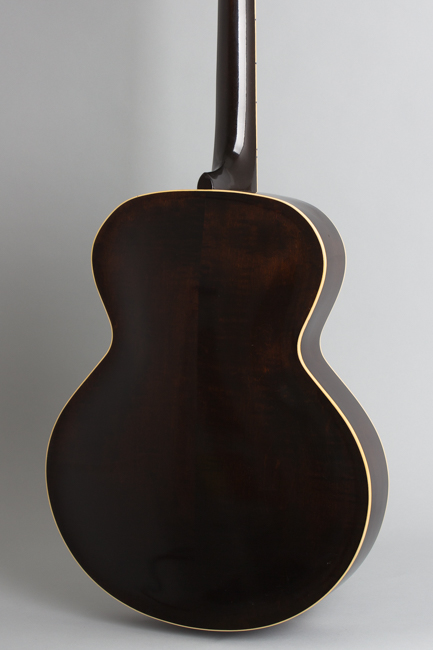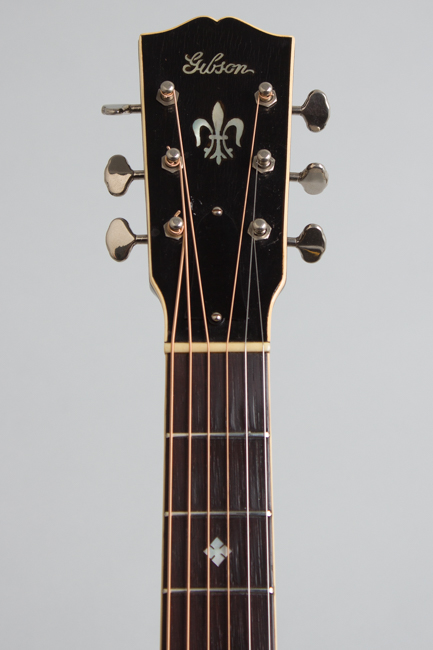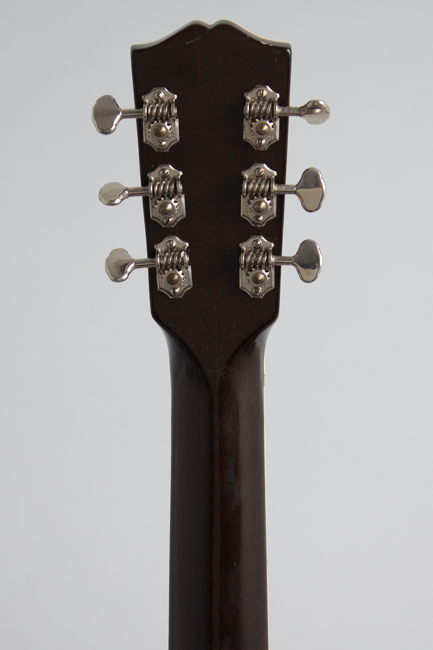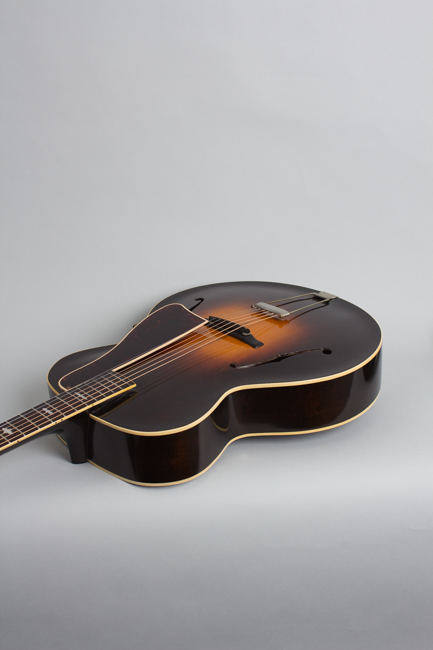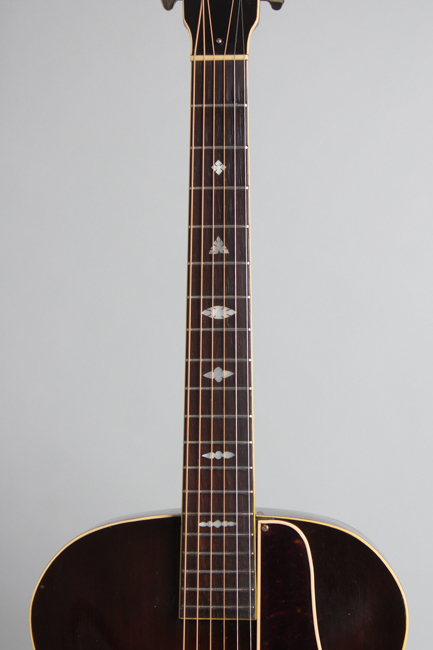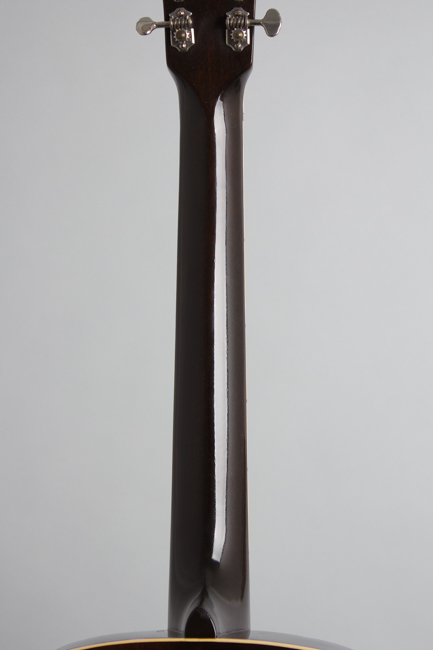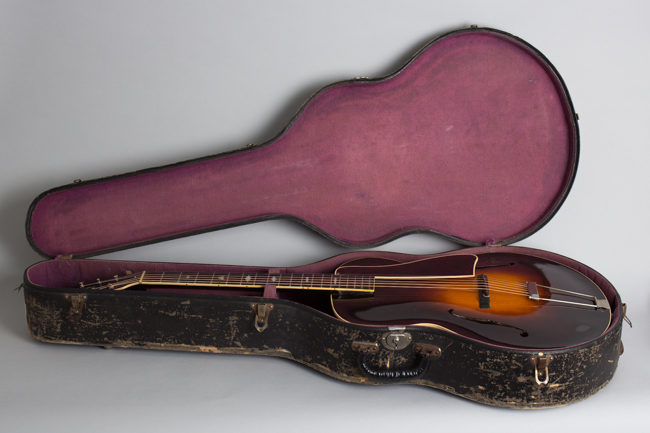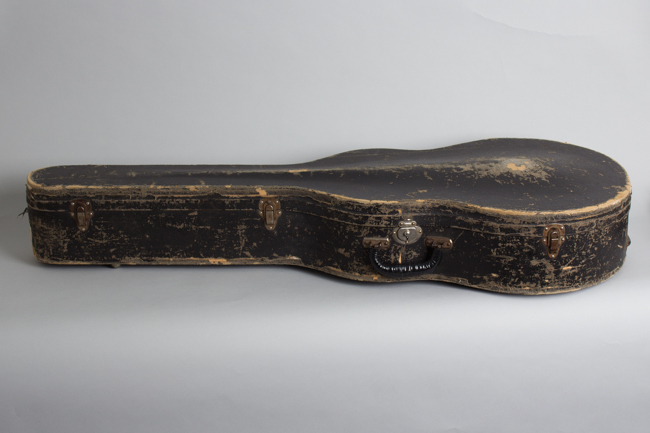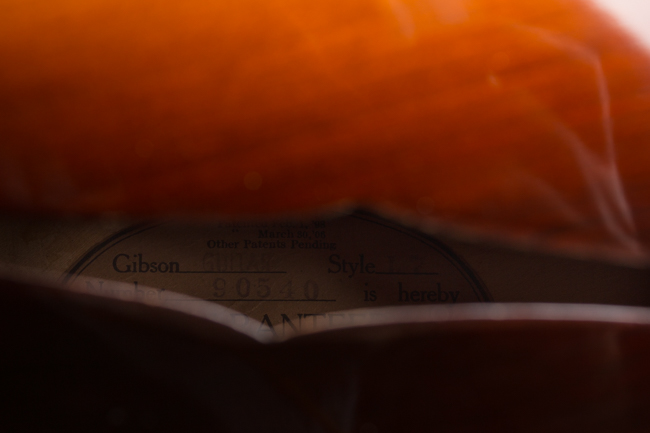Gibson L-7 Arch Top Acoustic Guitar (1934)
This item is currently on hold.
Item # 12768
Prices subject to change without notice.
Gibson L-7 Model Arch Top Acoustic Guitar (1934), made in Kalamazoo, Michigan, serial # 90540, sunburst top, dark back and sides finish, maple back and sides, spruce top, mahogany neck with rosewood fingerboard, original black hard shell case.
A very attractive pre-war Gibson archtop, this 16" L-7 shows some light wear but remains a superb looking and sounding guitar. This model was initially priced at $125, making it the least expensive of the new integrated line of F-hole professional orchestra guitars introduced beneath the L-5 in 1931-33, still a substantial professional grade instrument. This guitar has a serial number indicating shipment in 1934; the factory order number 901 dates to same year. This first-edition L-7 is distinguished by a bound fingerboard with "Nick Lucas" style shaped pearl inlay, a bound headstock with the script Gibson logo and fleur-de-lys inlay and a single bound body with a dark shaded sunburst on the top only.
With its 16" wide body, small unbound F-holes and fairly slim "V" profile neck this L-7 is still a close relative in feel and sound to the original 1924 L-5, the first modern archtop. These 16" "pre-Advanced" Gibson archtops have carved spruce tops that are parallel braced, unlike the X-braced 17" versions that replaced them in 1936. This entire series of mid-30s smaller-bodied Gibson archtops was quite short-lived, and many players are not aware of their special charms.
This guitar's original adjustable bridge is the smaller low-profile style mostly seen on lower-grade archtops but occasionally spotted on pro-grade models. The early Grover G-98 individual tuners, simple trapeze tailpiece and single-bound tortoise celluloid pickguard are typical Gibson fittings of the time. This mid-line guitar may lack some of the flashy looks of higher-priced models but still offers all of the sound value. It is a smooth and powerful sounding early swing-era guitar with a penetrating but deep and resonant tone, a very nice 16" carved top Gibson at a fraction of the cost of a period L-5.
Overall length is 40 1/2 in. (102.9 cm.), 16 1/4 in. (41.3 cm.) wide at lower bout, and 3 1/4 in. (8.3 cm.) in depth, measured at side of rim. Scale length is 24 3/4 in. (629 mm.). Width of nut is 1 11/16 in. (43 mm.).
This mid-'30's L-7 is a very nice example, looking beautiful overall, generally quite clean and an excellent player. There is some discoloration to spots of the top finish caused by the disintegration of the original celluloid pickguard, unfortunately a not uncommon problem. Some of the outgassing leeched into checks in the finish on the face, resulting in some darker lines running along areas of the top. This is not too distracting, and an excellent repro Paul Fox pickguard is now mounted. The body finish may have been polished out long ago, but we do not detect any wholesale overfinishing.
Beyond the celluloid decay marks the instrument shows only minor wear to the finish overall with a few small scratches, chips and dings. The only other really notable finish disturbance is a small touched up spot on the rim just below the heel. There are no visible cracks or repairs to the instrument.
The hardware remains all original except the pickguard, which is a superb exact reproduction. There is hardly any wear on the neck, the original frets and fingerboard have light wear in the lower positions. This very good sounding guitar simply does not appear to have been played much over 90 years. The sound is quite punchy when pushed but with a nice midrange sweetness as well, if played steadily it will only continue to improve. The guitar still resides in its original HSC, with some external wear but fully solid. Excellent - Condition.
A very attractive pre-war Gibson archtop, this 16" L-7 shows some light wear but remains a superb looking and sounding guitar. This model was initially priced at $125, making it the least expensive of the new integrated line of F-hole professional orchestra guitars introduced beneath the L-5 in 1931-33, still a substantial professional grade instrument. This guitar has a serial number indicating shipment in 1934; the factory order number 901 dates to same year. This first-edition L-7 is distinguished by a bound fingerboard with "Nick Lucas" style shaped pearl inlay, a bound headstock with the script Gibson logo and fleur-de-lys inlay and a single bound body with a dark shaded sunburst on the top only.
With its 16" wide body, small unbound F-holes and fairly slim "V" profile neck this L-7 is still a close relative in feel and sound to the original 1924 L-5, the first modern archtop. These 16" "pre-Advanced" Gibson archtops have carved spruce tops that are parallel braced, unlike the X-braced 17" versions that replaced them in 1936. This entire series of mid-30s smaller-bodied Gibson archtops was quite short-lived, and many players are not aware of their special charms.
This guitar's original adjustable bridge is the smaller low-profile style mostly seen on lower-grade archtops but occasionally spotted on pro-grade models. The early Grover G-98 individual tuners, simple trapeze tailpiece and single-bound tortoise celluloid pickguard are typical Gibson fittings of the time. This mid-line guitar may lack some of the flashy looks of higher-priced models but still offers all of the sound value. It is a smooth and powerful sounding early swing-era guitar with a penetrating but deep and resonant tone, a very nice 16" carved top Gibson at a fraction of the cost of a period L-5.
Overall length is 40 1/2 in. (102.9 cm.), 16 1/4 in. (41.3 cm.) wide at lower bout, and 3 1/4 in. (8.3 cm.) in depth, measured at side of rim. Scale length is 24 3/4 in. (629 mm.). Width of nut is 1 11/16 in. (43 mm.).
This mid-'30's L-7 is a very nice example, looking beautiful overall, generally quite clean and an excellent player. There is some discoloration to spots of the top finish caused by the disintegration of the original celluloid pickguard, unfortunately a not uncommon problem. Some of the outgassing leeched into checks in the finish on the face, resulting in some darker lines running along areas of the top. This is not too distracting, and an excellent repro Paul Fox pickguard is now mounted. The body finish may have been polished out long ago, but we do not detect any wholesale overfinishing.
Beyond the celluloid decay marks the instrument shows only minor wear to the finish overall with a few small scratches, chips and dings. The only other really notable finish disturbance is a small touched up spot on the rim just below the heel. There are no visible cracks or repairs to the instrument.
The hardware remains all original except the pickguard, which is a superb exact reproduction. There is hardly any wear on the neck, the original frets and fingerboard have light wear in the lower positions. This very good sounding guitar simply does not appear to have been played much over 90 years. The sound is quite punchy when pushed but with a nice midrange sweetness as well, if played steadily it will only continue to improve. The guitar still resides in its original HSC, with some external wear but fully solid. Excellent - Condition.
